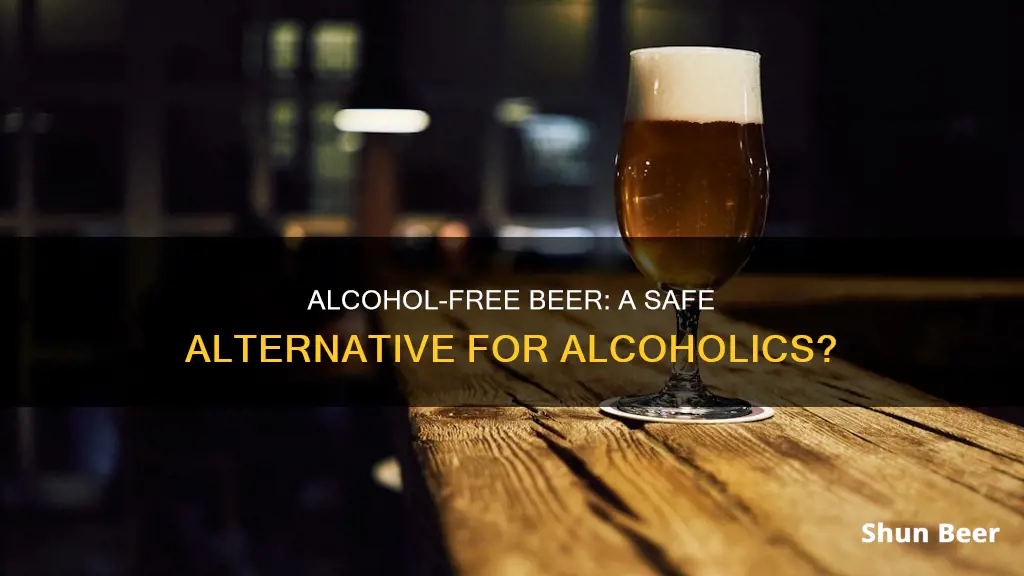
Alcohol-free beer is often presented as a safe alternative to alcoholic beer, but it is important to be aware of the risks before trying it. Alcohol-free beer is designed to match the taste, look, and feel of standard beers, and it can be a good way to stick to low-risk drinking guidelines. However, it is crucial to understand that alcohol-free beer is not completely free of alcohol and can contain up to 0.5% alcohol by volume (ABV). This means that it may not be a suitable option for individuals who need or want to avoid alcohol completely, such as those with alcohol use problems, pregnant people, or those with specific medical conditions.
The decision to consume alcohol-free beer during sobriety is usually a personal one, and it depends on various factors. Some individuals may find that the taste and ritual of drinking beer, even without alcohol, can act as a trigger and lead to cravings for alcoholic beverages. On the other hand, alcohol-free beer can provide a sense of normalcy and inclusion in social settings for some people, allowing them to participate in the social ritual of drinking without compromising their sobriety goals. It is important for individuals to carefully reflect on their reasons for considering alcohol-free beer and to be aware of their personal triggers and comfort levels with the potential physical and psychological effects.
Should Alcoholics Drink Alcohol-Free Beer?
| Characteristics | Values |
|---|---|
| Alcohol Content | Alcohol-free beer typically contains 0.05% alcohol by volume (ABV) or less. However, some products may contain up to 0.5% ABV. |
| Health Risks | Alcohol-free beer may not be suitable for individuals with specific medical conditions, such as liver disease, or for those who are pregnant or breastfeeding. |
| Psychological Impact | For some individuals in recovery, the taste and ritual of drinking beer, even without alcohol, can act as a trigger and lead to cravings for alcoholic beverages. |
| Social Benefits | Alcohol-free beer can provide a sense of normalcy and inclusion in social settings, allowing individuals to participate in the social ritual of drinking without compromising their sobriety goals. |
| Individual Variation | The decision to consume alcohol-free beer during sobriety is usually a personal choice and depends on factors such as an individual's definition of sobriety, potential triggers, and the support of their network. |
What You'll Learn

Alcohol-free beer may still contain alcohol
In the US, the Food and Drug Administration (FDA) requires products marketed as alcohol-free to contain 0.0% ABV, meaning there are no detectable levels of alcohol in the product. However, research suggests that many non-alcoholic beers contain more alcohol than their labels indicate. A 2010 study found that 29% of no- or low-alcohol beers tested had higher alcohol levels than the labels suggested. Of the zero-alcohol beers sampled, six were found to have alcohol levels higher than one percent.
In the UK, government guidance states that alcohol-free drinks may contain up to 0.05% ABV, but this is only voluntary guidance, so some alcohol-free beers may contain up to 0.5% ABV. This means that a half-litre can of 0.5% ABV beer would contain 0.25 units of alcohol, or a quarter of a unit of alcohol.
The presence of alcohol in alcohol-free beer, even in small amounts, can be dangerous for certain populations. For example, individuals with liver impairments may develop much higher blood alcohol levels than normal after consuming non-alcoholic beer, and the smell of beer may serve as a relapse trigger for people recovering from alcohol use disorder. Additionally, pregnant individuals should avoid drinking any alcohol during pregnancy to avoid the risk of fetal alcohol spectrum disorder (FASD).
Mixing Beer and Rum: Safe or Not?
You may want to see also

The pros and cons of drinking alcohol-free beer for social inclusion
Alcohol-free beer has become an increasingly popular alternative to standard beer in recent years. It is produced in a similar way to regular beer, but the alcohol content is either significantly reduced or removed entirely during the brewing process. While some people view it as a healthy alternative to standard beer, others question its suitability for those in recovery from alcoholism. The following paragraphs explore the pros and cons of drinking alcohol-free beer for social inclusion.
The Pros
One of the main advantages of alcohol-free beer is its potential to promote social inclusion. It enables people who don't drink alcohol, whether for health, religious, or personal reasons, to feel included in social situations where alcohol is present. This can help combat feelings of isolation and promote stronger social connections. Alcohol-free beer can also be a useful tool for those trying to cut back on alcohol or abstain entirely, as it allows them to enjoy the social aspects of drinking without the risks associated with excessive alcohol consumption.
The Cons
However, there are also some potential drawbacks to consider. Firstly, despite improvements in brewing techniques, some alcohol-free beers may still have a slightly different taste compared to regular beer, which could be a deal-breaker for those who value the traditional beer flavour. Additionally, while the variety of alcohol-free beers is growing, it is still limited in comparison to the vast array of regular beers available on the market, which can make it challenging for alcohol-free beer drinkers to find their preferred style or brand.
Another important consideration is the possibility of trace amounts of alcohol in alcohol-free beers. Although marketed as alcohol-free, some may still contain up to 0.5% alcohol, which is crucial information for individuals who need to completely abstain from alcohol for health, religious, or personal reasons. Therefore, it is essential to carefully read the label to ensure the beer meets one's requirements.
In conclusion, alcohol-free beer offers a range of benefits, including social inclusion, absence of hangovers, and potential health advantages. However, there are also some downsides, such as taste differences, limited options, and the possibility of trace amounts of alcohol. Ultimately, the decision to consume alcohol-free beer depends on individual preferences and circumstances, weighing the pros and cons accordingly.
Florida Driving: Beers and Legal Boundaries
You may want to see also

The psychological impact of drinking alcohol-free beer
Alcohol-free beer is designed to replicate the taste, look, and feel of standard beers. While it can be a good way to stick to low-risk drinking guidelines, it is not suitable for people who need or want to avoid alcohol completely. This is because most alcohol-free beers still contain a small amount of alcohol (up to 0.5% ABV).
On the other hand, some people in recovery may find that alcohol-free beer helps them feel included in social gatherings and takes the edge off without the risk of losing control or experiencing negative consequences. It can be a way to indulge without worrying about controlling their drinking or the potential for harmful behaviors.
Ultimately, the decision to drink alcohol-free beer is a personal one and depends on an individual's triggers and their ability to manage their drinking. Some people may find that it helps them stay sober, while others may find that it triggers cravings and makes them more likely to relapse. It is important for individuals to be aware of their own triggers and make informed decisions about their consumption of alcohol-free beer.
Beer Schooner Standard Drinks: How Many is Too Many?
You may want to see also

Alcohol-free beer as a trigger for cravings
Alcohol-free beer is often presented as a safe alternative to regular beer, but it is important to be aware of the risks before consuming it, especially for those with alcohol use problems. While it may seem like a good option for those looking to limit their alcohol intake, it is essential to consider the potential dangers.
The Risks of Alcohol-Free Beer
Although alcohol-free beer contains little to no alcohol, it can still pose risks, especially for those with a history of alcohol abuse. Here are some reasons why alcohol-free beer may trigger cravings:
- Similar Taste and Smell: Alcohol-free beer is designed to mimic the taste, look, and feel of regular beer. The similar smell and taste of alcohol-free beer to regular beer can trigger cravings and lead to a relapse, especially if it reactivates old behavioural patterns.
- Presence of Alcohol: Alcohol-free beer may still contain small amounts of alcohol (up to 0.5% ABV). This small amount of alcohol can trigger those in recovery to justify having a stronger drink or result in an addiction to alcohol-free beer itself.
- Psychological Addiction: The addictive potential of alcohol-free beer lies more in the psychological aspects, such as the routine, taste, or context associated with drinking. For those with a history of alcohol addiction, the ritual around drinking may be just as addictive as the alcohol itself.
- Euphoric Recall: Tasting alcohol-free beer can trigger euphoric recall, which is the memory of the good times associated with drinking. For alcoholics, this can be a powerful trigger, as they often have difficulty remembering the negative consequences of their drinking.
Managing Cravings
If you are trying to maintain sobriety, it is important to be aware of your triggers and take steps to avoid them. Here are some strategies to manage cravings:
- Understand your triggers: Identify the specific people, places, and situations that cue your urge to drink and try to avoid them, especially in early recovery.
- Build a support system: Connect with others who are also trying to stop drinking, and seek emotional support from friends and loved ones.
- Distract yourself: Engage in positive distractions such as listening to music, reading, going for a walk, or practising mindfulness or relaxation techniques.
- Change your environment: Move your wine rack, choose restaurants that don't serve alcohol, and spend time with friends in places that don't trigger drinking.
- Seek professional help: Therapy, medication, and recovery programs can be beneficial in reducing and preventing cravings.
Alternatives to Alcohol-Free Beer
If you are looking for an alternative to alcohol-free beer, here are some lower-risk options:
- Seltzer water or other sparkling water
- Caffeinated beverages like soda or coffee
- Fresh-squeezed juice
- Making lifestyle changes, such as eating a balanced diet, engaging in regular physical activity, getting enough sleep, and finding healthy hobbies and leisure activities.
Alcoholics and NA Beer: Is It a Safe Option?
You may want to see also

The taste of alcohol-free beer
The taste of non-alcoholic beer has been a topic of discussion for many beer enthusiasts. Some people find non-alcoholic beer to be flat and watery. This is because the process of removing alcohol, such as by heating the drink, also kills the aroma that comes from hops, resulting in a poor aroma. In addition, the absence of alcohol affects the mouthfeel and taste of the beer, making it less flavourful and satisfying for some drinkers.
However, recent advances in production technology and brewing techniques have improved the taste of non-alcoholic beer. For example, researchers at the University of Copenhagen have developed a method to brew non-alcoholic beer that tastes like regular beer by adding monoterpenoids, which provide the hoppy flavour, at the end of the brewing process. This innovation not only improves the taste but also makes the brewing process more sustainable by reducing water usage and carbon emissions.
The taste of non-alcoholic beer can vary depending on the brand and brewing method. Some people find that certain non-alcoholic beers, such as Buckler and Clausthaler, taste more like regular beer than others. Additionally, craft breweries have been experimenting with different styles, such as IPAs, stouts, and lagers, to offer more flavourful and innovative options.
It is worth noting that individual taste preferences play a significant role in how one perceives the taste of non-alcoholic beer. Some people may find that certain brands or styles suit their palate better than others. It is a matter of personal preference whether one enjoys the taste of non-alcoholic beer or finds it lacking in comparison to its alcoholic counterpart.
While the taste of non-alcoholic beer has improved, it may still be challenging to perfectly replicate the complex flavours and aromas of regular beer without the presence of alcohol. However, with ongoing advancements in brewing techniques and a growing market demand for tasty non-alcoholic options, we may see even more delicious and satisfying alcohol-free beers in the future.
Beer Drinking: Everyday Habit or Unhealthy Vice?
You may want to see also
Frequently asked questions
Non-alcoholic beer is a type of beer that has very little or no alcohol. It is usually produced by removing the alcohol from regular alcoholic beer.
Non-alcoholic beer may be a safe alternative for some people, but it carries potential dangers, especially for those with alcohol problems and pregnant people.
Research suggests that many non-alcoholic beers contain more alcohol than their labels indicate. It may also trigger cravings and a subsequent relapse among certain people with alcohol use disorder.
Non-alcoholic beer should be avoided by those who are pregnant or trying to become pregnant, as well as those with a history of alcohol problems. Additionally, individuals with specific medical conditions, such as liver disease, or those undergoing certain addiction treatment programs may need to avoid it.
Non-alcoholic beer can be beneficial for individuals who want to reduce their alcohol intake while still enjoying the social and cultural aspects of beer consumption. It can also provide a sense of normalcy and inclusion in social settings where alcohol is present.







